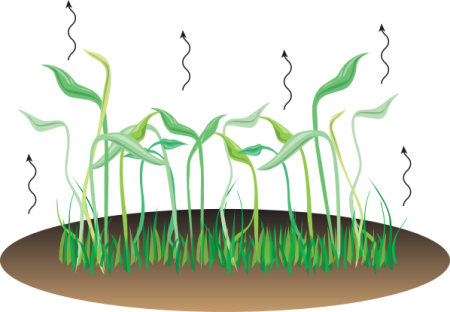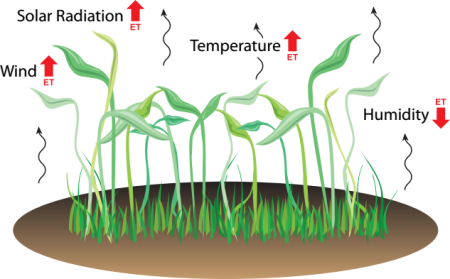Evapotranspiration: What It Is and How It Is Helpful
by Bruce Smith | Updated: 06/08/2017 | Comments: 3
Have you ever heard someone mention "ET" and wondered what it meant? Assuming the person wasn’t talking about extra-terrestrials or Entertainment Tonight, the conversation was probably about evapotranspiration. Evapotranspiration (or "ET") is the water lost through plant transpiration and soil and plant evaporation. The images below help explain what ET is and how it occurs.

Evapotranspiration (ET) is the combination of evaporation and transpiration. Evaporation is water movement from wet soil and leaf surfaces. Transpiration is water movement through the plant. This water movement helps move vital nutrients through the plant.

Evapotranspiration (ET) is an energy-driven process. ET increases with temperature, solar radiation, and wind. ET decreases with increasing humidity.
So, how exactly is knowing the ET helpful? You can use ET to determine when and how much irrigation water is needed. A common use is with turf grass irrigation. As an example, if your irrigation system applies 0.5 inches of water during one irrigation event, with no rainfall and an ET loss value for 2 days in a row of 0.25 inches, you would need to irrigate after these 2 days.
Calculating Reference Evapotranspiration
With a few weather measurements and site location information, you can use a mathematical formula to estimate the “Reference Evapotranspiration.”
Note: Rain totals are not part of the Reference Evapotranspiration, and they should be compensated for as necessary. For example, a rain total of 0.15 inches in one day with an ET value of 0.25 inches for the same day would be a net loss of 0.10 inches.
When using the Reference Evapotranspiration formula, these are the weather measurements you need and their importance:
- Solar Radiation – Constitutes up to 80% of the equation depending on conditions.
- Air Temperature – Ties for 2nd place with wind speed.
- Wind Speed – Ties for 2nd place with air temperature.
- Relative Humidity – Has a noticeable effect when the air is really dry or really humid.
In addition to these weather measurements, you need the height of the wind speed sensor, as well as the latitude, longitude, and elevation of the site location.
Tip: The site location of your weather station is very important. It is ideal to place your weather station in a location that is a good representation of the crop of interest. With turf grass, for example, your weather station should be surrounded by turf and located away from trees and buildings that can affect the wind and sun exposure experienced by the weather station sensors.
To get a little more technical, here’s a look at the science behind estimating the Reference Evapotranspiration:
ASCE Standardized Reference Evapotranspiration Equation

where:
| ETSZ | = standardized reference crop evapotranspiration for short (ETos) or tall (ETrs) surfaces (mm d-1 for daily time steps or mm h-1 for hourly time steps), |
| Rn | = calculated net radiation at the crop surface (MJ m-2 d-1 for daily time steps or MJ m-2 h-1 for hourly time steps), |
| G | = soil heat flux density at the soil surface (MJ m-2 d-1 for daily time steps or MJ m-2 h-1 for hourly time steps), |
| T | = mean daily or hourly air temperature at 1.5 to 2.5-m height (°C), |
| u2 | = mean daily or hourly wind speed at 2-m height (m s-1), |
| es | = saturation vapor pressure at 1.5 to 2.5-m height (kPa), calculated for daily time steps as the average of saturation vapor pressure at maximum and minimum air temperature, |
| ea | = mean actual vapor pressure at 1.5 to 2.5-m height (kPa), |
| Δ | = slope of the saturation vapor pressure-temperature curve (kPa °C-1), |
| γ | = psychrometric constant (kPa °C-1), |
| Cn | = numerator constant that changes with reference type and calculation time step (K mm s3 Mg-1 d-1 or K mm s3 Mg-1 h-1) and |
| Cd | = denominator constant that changes with reference type and calculation time step (s m-1). |
Units for the 0.408 coefficient are m2 mm MJ-1.
Example of Weather Data for One Day and the ET Value Calculated
| Time Stamp | Average Solar W/M2 | Average AirTempF | Average AirRH | Average WindMPH | ET in Inches |
|
9:00 AM |
463.9 |
65.59 |
51.83 |
5.2 |
0.01 |
|
10:00 AM |
394.2 |
67.82 |
51.08 |
3.64 |
0.01 |
|
11:00 AM |
468.1 |
70.92 |
46.21 |
2.9 |
0.01 |
|
12:00 PM |
880 |
76.89 |
38.74 |
2.75 |
0.02 |
|
1:00 PM |
940 |
82.49 |
32.01 |
2.47 |
0.03 |
|
2:00 PM |
856 |
85.98 |
21.9 |
4.52 |
0.03 |
|
3:00 PM |
813 |
88.27 |
15.68 |
3.2 |
0.03 |
|
4:00 PM |
693.1 |
88.99 |
14.89 |
4.61 |
0.02 |
|
5:00 PM |
532.9 |
89.02 |
15.38 |
4.26 |
0.02 |
|
6:00 PM |
370.8 |
89.96 |
15.31 |
2.71 |
0.01 |
|
7:00 PM |
192.8 |
88.54 |
18.72 |
2.27 |
0.01 |
|
8:00 PM |
36.53 |
82.71 |
23.88 |
4.25 |
0 |
|
9:00 PM |
0.18 |
82.29 |
15.15 |
6.88 |
0 |
|
10:00 PM |
0 |
79.14 |
21.33 |
5.69 |
0 |
|
11:00 PM |
0 |
77.81 |
21.66 |
2.81 |
0 |
|
12:00 AM |
0 |
71.13 |
34.35 |
8.71 |
0 |
|
1:00 AM |
0 |
66.94 |
40.53 |
12.69 |
0 |
|
2:00 AM |
0 |
63.79 |
47.4 |
8.22 |
0 |
|
3:00 AM |
0 |
61.34 |
52.9 |
3.21 |
0 |
|
4:00 AM |
0 |
58.66 |
59.1 |
1.88 |
0 |
|
5:00 AM |
0.86 |
55.9 |
65.98 |
2.09 |
0 |
|
6:00 AM |
43.35 |
55.2 |
68.56 |
1.45 |
0 |
|
7:00 AM |
214.1 |
60.3 |
59.44 |
3.42 |
0.01 |
|
8:00 AM |
393.5 |
64.08 |
52.49 |
3.7 |
0.01 |
|
Total ET |
0.22 |
||||
Using the ET to Adjust Irrigation Schedules
There are some smart irrigation controllers that can be used to automatically adjust the irrigation schedule based on the ET. The best controllers use accurate local weather information to produce the ET value to be used for irrigation scheduling. One example is the Weather Reach Controller Link.
I hope this information has helped you understand the basics of ET. If you have comments or questions, feel free to share them.




 Bruce Smith is a Technical Support Engineer at Campbell Scientific, Inc. He provides technical support for many Campbell Scientific products and specializes in supporting weather stations used in the commercial irrigation industry. Bruce’s background is in building maintenance. Away from work, he enjoys spending time with his family and dogs, being outdoors, and tinkering with cars.
Bruce Smith is a Technical Support Engineer at Campbell Scientific, Inc. He provides technical support for many Campbell Scientific products and specializes in supporting weather stations used in the commercial irrigation industry. Bruce’s background is in building maintenance. Away from work, he enjoys spending time with his family and dogs, being outdoors, and tinkering with cars.
Comments
GAG | 09/14/2017 at 08:41 PM
Hello, Chod,
I am waiting for a Solar radiation sensor that have a builld in tilt sensor a long time. Now it is coming. Great!
CS320 has an embedded 3-D tilt sensor. could you tell us if it use the orientation information to calibrate the measurement radiation data? Or can we do can in our programs?
Thanks.
Chod | 09/15/2017 at 01:29 PM
Hi!
Thank you for your question about the CS320 and its built-in tilt sensor. As of right now, the information from the tilt sensor is only being reported to the user. The sensor's calibrated response is assuming that the sensor is mounted level and pointing up. I don't anticipate using the data to correct for errors imposed by an improperly installed sensor, but you may be able to use the data in your datalogger program for anything that you would like. Thanks again for the question.
Chod
Shawn_H | 06/29/2018 at 03:32 PM
Hi Chod, I am echoing the previous comment a little, but we are considering installing this sensor on an ocean buoy.
You wrote "I don't anticipate using the data to correct for errors imposed by an improperly installed sensor, but you may be able to use the data in your datalogger program for anything that you would like. "
Do you have a method or know of one that is used for correcting the data using the output from the tilt sensor?
Essentially, has someone else already done the hard work of determining the effect of tilt on this sensors output?
ddb | 06/02/2021 at 09:28 AM
Mr. Stephens,
We are switching from the LI200R pyronometer to the CS320 pyronometer at all of our climate stations. We are wondering what differences to expect between the two? If we utilize the internal heater on the CS320 can be anticipate greater differences? Are you aware of any comparisons across the two?
David B
Please log in or register to comment.